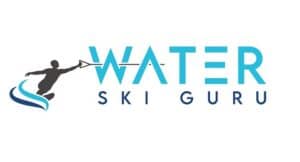A regulation slalom course is 850 feet long and 75.4 feet wide. It also includes 26 buoys that mark the course – 16 buoys guide the skier into the course and through each turn and 10 buoys mark a straight path for the boat to follow.
This guide will cover ten important tips for setting up your own slalom water ski course!
Slalom Water Ski Course Dimensions
A regulation water ski course is 850 feet long and 75.4 feet wide. It has six turn buoys that skiers must navigate around. Slalom courses also have 20 buoys to mark the course for the boat to follow.
Slalom water ski courses are built to very exact dimensions for racing competitions. This is done to allow the results from one competition to be compared to another event. Without standard configurations, we’d end up arguing over who is the best slalom skier!
How Long is a Water Ski Slalom Course
A regulation slalom course is 850 feet long and 75.4 feet wide.
It’s important to note that these dimension are just for the buoys. A lot more space is required at the entrance and exit of the course and on both sides of the turn buoys for safety and maneuvering the boat.
In general, a slalom course should have at least 500 feet of approach space at the beginning of the course and the same distance at the end. This means you need a minimum of 1,850 feet (850 feet for the course and 1,000 feet of starting and stopping distance. More runway room is better, if you have the space.
This length provide enough distance for the boat to get the skier out of the water and up to the proper speed for the run before entering the course. The starting area should also be in line with the course so the boat doesn’t have to make a turn at the start of the run.
A slalom course is 75.4 feet wide. This is the distance between the turn buoys. For safety, you need room on either side to keep the skier away from the shore or other obstructions. Some states have minimum distances from the shore where motorized boats can operate above “no-wake speeds”.
Depending on shoreline constraints where your course is located and the state regulations, you should provide at least 100 feet on either side of the course. This works out to a total width of 275 feet for a slalom course.
The last dimension to consider is the depth of water. Most ski boats require 2 to 4 feet of draft. You also need enough depth for skier safety. The minimum depth of water for your slalom course should be 5 feet or more. If there is a tide where you’re setting up your course, use the low tide depth!
Water Ski Course Layout
A slalom course is set up to guide the boat and skier through the course. The figure to the left shows a regulation course. Note the 6 turn buoys, the 2 entrance gate buoys, the 2 exit gate buoys, and the boat guide buoys. All of the skier buoys are red and the boat buoys are yellow.
Although not part of the regulation course, every slalom course has a boat entry and exit area. This additional space allows the boat to pull the skier out of the water and get up to speed before they enter the course. At the end of the course is a long run of water that allows the skier to safely drop and the boat to slow down.
Water Ski Slalom Course Diagram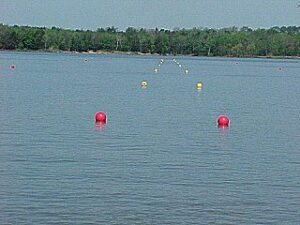
The figure to the right shows a boat and skier during a slalom course run. The boat is required to stay between the yellow boat guide buoys for the entire course.
The skier must navigate around the outside of the 6 red turn buoys to complete the course. In addition, the skier must enter between the 2 entrance gates and exit between the 2 exit gates.
Slalom Course Accuracy
For a practice course, it doesn’t matter if your course dimensions are accurate or not. You really just need them to be within about 10 or 20% of the official dimensions. Many people just eyeball their course. Others use their cellphone GPS.
Remember – a practice course is just that. For practice. You use it to train and have fun.
A competition course, on the other hand, must be laid out to very exacting specifications. The official rules require that the buoys must be surveyed by a licensed surveyor!
The distance from the turn buoy to the center line of the course must be 37′-8¾”. There is a tolerance of 37′-4¼” to 38′-1-3/8″. As you can, these are very precise tolerances!
Slalom Course Buoys
A slalom ski course has two types of buoys – the skier and boat buoys. There are a total of 26 buoys on a standard slalom course. Buoys are color coded to avoid confusion and clearly identify their purpose.
Slalom course buoys are designed to be safe so they don’t injure skiers or damage boats if they’re accidentally struck. They are made of lightweight, pliable materials and have a smooth surface.
Skier Buoys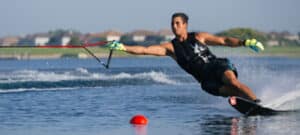
There are 10 buoys that tell the skier how to navigate the course. A slalom course has entrance gates at the beginning and end of the course, and 6 turn buoys along the course. All of the skier buoys are red.
Turn Buoys: A regulation slalom course has six boys that the skier must navigate around. These are called turn buoys because they mark the distance from the center of the course that the skier must ski around before turning to cross back to the other side.
The skier must navigate around the outside of each buoy as shown in the figure. Each turn buoy is 37.7 feet from the center line of the course.
Entrance Gates: There are 2 buoys at the start and 2 at the end of the course that the skier must go through. If they miss these buoys, the run doesn’t count.
Boat Guide Buoys: A slalom course has 16 boat guides buoys that mark the path for the boat to follow. The buoys that the boat passes through are 4.3 feet apart. Pairs of boat guide buoys are located every 134.5 feet apart along the length of the course.
All of the boat buoys are yellow.
How Many Buoys Are in a Slalom Course
There are a total of 26 buoys on a competition slalom course.
Six buoys are used to mark the turns that the skier must follow. These buoys are known as turn buoys.
Another 4 buoys mark the entrance and exit of the course for the skier to begin the run.
There are 16 buoys that mark the course that the boat must follow.
How Far Apart Are Slalom Buoys
Slalom buoys are positioned very precisely according to national and international standards.
The turn buoys are 37.5 feet from the center line. The diagonal distance from one turn buoy to the next is 154 feet. This is the approximate distance that the skier covers between each turn.
The boat-gate buoys are positioned 134.5 feet apart. There are two gate buoys marking the path that the boat must past between. This ensures the boat is moving in a straight line.
How Big are Ski Buoys
A regulation buoy is 40″ in diameter and 12.25” tall.
Skier buoys (turn and gate buoys) are spherical in shape with a diameter of 7.8 to 11 inches. They have to float with at least 3.9 inches of the buoy above the water.
The boat guide buoys can be spherical, cylindrical, or bullet-shaped. Spherical buoys are 8-3/4 to 11 inches in diameter. Cylindrical buoys are approximately 4 – 9 inches.
Who Determines the Dimensions for Slalom Courses
Regulation slalom course dimensions and layouts are determined by national and international governing bodies.
In the United States, the USA Water Ski & Wake Sports (USAWS) is the official water skiing agency. They set the rules and standards for all water ski competitions, including the dimensions for slalom courses. They are a member of the International Waterski & Wakeboard Federation, which is the world governing body for water skiing.
I read the USAWS’s rules to prepare this article – all 119 pages of them! They cover everything from the course dimensions and layout to the size and type of boat to who can compete in the various divisions.
Getting Approval for Your Slalom Course
Don’t assume you can just build a slalom course without getting approval. Anytime you build something on the water – even if it’s just buoys – you’ll need permission.
The location of the course is going to have an impact on what type of permits are needed. For example, some states may require a permit for anchoring in public waters. You might also need approval from the town or county where the course is located.
Typically, the state natural resource department or environmental protection agency is in charge of issuing permits for public waters. If there’s federal control over the water where you want to build your course, then it will be necessary to get permission from Army Corps of Engineers as well.
On many lakes, the addition of a slalom course will require a public hearing where members of the community can comment on your request. You could encounter some opposition from people that don’t want waterskiing on their lake.
Oftentimes these types of conflicts can be resolved by educating citizens about how safe it is when done properly or providing them with an alternative area. Most concerns are related to fears of being hit by powerboats or excessive wakes near their docks.
Buying a Portable Slalom Course
If you want a slalom course, but don’t want to figure everything out, you’re in luck. There are several manufacturers who have done all the work for you.
They offer courses that meet the official requirements. Plus, they provide the convenience of a pre-made course.
You can purchase a portable slalom course that allows a quick and easy setup process. A portable system cuts down on the time it takes to set up a slalom course. In addition, it includes everything you need so there’s no figuring out what’s required and how it all goes together.
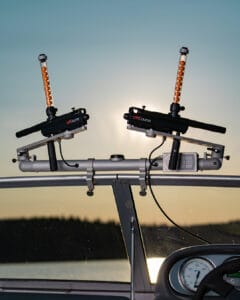 OffCourse Portable Slalom Course
OffCourse Portable Slalom Course
The OffCourse is the revolutionary portable waterski slalom course that will revolutionize your water skiing. You can choose a spot on any lake and this bad boy will build you an instant temporary waterskier’s dream! Say goodbye to wasted time by going back and forth just to get right back in position- The Offcourse guarantees 24 consecutive turns of perfect, exciting game play for every level of skier out there.
This system consists of a paintball that is launched from a tube on your boat. The launcher is powered by your boat’s battery and 12-gram CO2 cartridges. The paintballs are made from a clear biodegradable gelatine. The course is marked by the splash of the paintball that is fired from the boat. It can place up to 45 turn “buoys” with an optional loader.
It is surprisingly accurate, especially since the course “buoys” are just paintballs that make a splash and dye mark in the water. The manufacturer claims that each turn “buoy” is within 5 inches of the official course dimensions.
Insta-Slalom Portable Slalom Course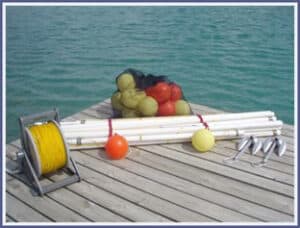
When you want some quick slalom action, Insta-Slalom is your best option. With its portable size and set up time of 12 minutes or less it’s perfect for on the go adventures. It can be taken to any destination with ease thanks to a compact design that fits in cars, boats or other vehicles! No tools required means no hassle as well so get ready for fast paced racing at pretty much anytime because this course will never let you down.
Final Take on Slalom Courses
Slalom water skiing is a great sport. The ultimate test of your skills is to take a run through a slalom course.
A slalom course includes turn buoys, entry and exit gates, and boat guides. You may want a slalom course for your favorite lake or river. If this sounds like something you’d be interested in setting up, here’s 10 tips on how to get started with building one of these great water skiing tracks around your property. Happy skiing!
